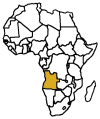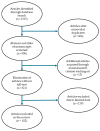A Review of Medicinal Plants Used in the Management of Microbial Infections in Angola
- PMID: 39519911
- PMCID: PMC11548206
- DOI: 10.3390/plants13212991
A Review of Medicinal Plants Used in the Management of Microbial Infections in Angola
Abstract
The use of medicinal plants in the management of microbial infections is significant to the health of the indigenous people in many Angolan communities. The present study provides a comprehensive overview of medicinal plants used for the management of microbial infections in Angola. Relevant information was extracted from research articles published and associated with the use of medicinal plants in the management of microbial infections in Angola (from January 1976 to November 2023). Data or information were gathered from the literature sourced from Wiley Online, SciFinder, Google Scholar, Web of Science, Scopus, ScienceDirect, BMC, Elsevier, SpringerLink, PubMed, books, journals and published M.Sc. and Ph.D. thesis. A total of 27 plant species, representing 19 families, were recorded in this study. Hypericaceae (11%), Lamiaceae (11%), Malvaceae (11%), Phyllanthaceae (11%), Fabaceae (16%) and Rubiaceae (16%) were the most predominant families. The leaves are the most used parts (96%), followed by bark (74%) and root (70%). The data revealed that medicinal plants continue to play significant roles in the management of microbial infections in Angola. In order to explore the benefits of the therapeutic potential of indigenous medicinal plants for diseases related to infections; further scientific research studies are important to produce data on their effectiveness using appropriate test models. This approach might assist with the continuing drive regarding the integration of Angolan traditional medicine within mainstream healthcare systems.
Keywords: Angolan medicinal plants; antibacterial activity; antimicrobial activity; botanical description; distribution; ethnobotany; pharmacology; phytochemistry; taxonomy.
Conflict of interest statement
The authors declare no conflicts of interest.
Figures
Similar articles
-
A Review on Medicinal Plants Used in the Management of Headache in Africa.Plants (Basel). 2021 Sep 28;10(10):2038. doi: 10.3390/plants10102038. Plants (Basel). 2021. PMID: 34685845 Free PMC article. Review.
-
Medicinal plants used by 'root doctors', local traditional healers in Bié province, Angola.J Ethnopharmacol. 2020 Oct 5;260:112662. doi: 10.1016/j.jep.2020.112662. Epub 2020 Mar 6. J Ethnopharmacol. 2020. PMID: 32147477
-
Ethnobotany in Angola: The contribution of late 19th century christian missionaries to the knowledge of medicinal wild plants.J Ethnopharmacol. 2024 Nov 15;334:118511. doi: 10.1016/j.jep.2024.118511. Epub 2024 Jul 3. J Ethnopharmacol. 2024. PMID: 38969150
-
Ethnomedicinal uses, phytochemistry, and pharmacology of the genus Vepris (Rutaceae): A review.J Ethnopharmacol. 2021 Mar 1;267:113622. doi: 10.1016/j.jep.2020.113622. Epub 2020 Nov 25. J Ethnopharmacol. 2021. PMID: 33246126 Review.
-
An overview on ethnobotanico-pharmacological studies carried out in Morocco, from 1991 to 2015: Systematic review (part 1).J Ethnopharmacol. 2021 Mar 1;267:113200. doi: 10.1016/j.jep.2020.113200. Epub 2020 Aug 1. J Ethnopharmacol. 2021. PMID: 32750461
Cited by
-
Cochlospermum angolense Welw ex Oliv: Phytochemical Profile, Antioxidant Activity, and Therapeutic Prospects.Molecules. 2025 Jun 27;30(13):2768. doi: 10.3390/molecules30132768. Molecules. 2025. PMID: 40649281 Free PMC article.
References
-
- Nasir B., Fatima H., Ahmed M., Haq I.U. Recent trends and methods in antimicrobial drug discovery from plant sources. Austin. J. Microbiol. 2015;1:1002
-
- Boutayeb A. Handbook of Disease Burdens and Quality of Life Measures. Springer Nature; Berlin, Germany: 2010. The impact of infectious diseases on the development of Africa; pp. 1171–1188. - DOI
Publication types
LinkOut - more resources
Full Text Sources
Molecular Biology Databases



